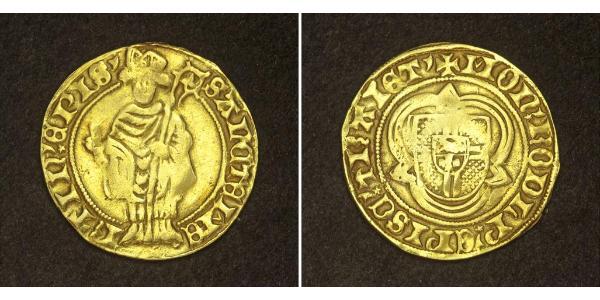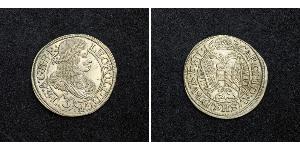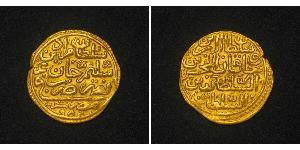(sold for $265.0)
1455, Bishopric of Utrecht, Rudolf van Diepholt. Gold Florin (Gold Gulden) Coin. F-VF Region: Netherlands Mint year: 1433-1455 Mint Place: Bishopric of Utrecht Bishop: Rudolf van Diepholt (1423-1455) Reference: Delmonte 939, Friedberg 188. R! Denomination: Gold Florin (Florin d'or) - also known as St. Martin Gold Gulden Condition: Tooling spot at 12 o'clock (removed from jewellery), worn/cleaned/polished, otherwise F-VF. Material: Gold (average purity!) Diameter: 23mm Weight: 3.24gm Obverse: Standing draped figure of Saint Martin, holding crozier in left hand, right hand in benediction. Legend: SANCTE ME-RTIN.'EPIS' Reverse: Shield of the Bishopric of Utrecht within trefoil. Legend: + MON' RODLP' EPISC' TRAIET' The Bishopric of Utrecht is a Diocese based in the Dutch city of Utrecht. It was one of the Prince-Bishoprics of the Holy Roman Empire. The Bishopric of Utrecht continued as a state of the Holy Roman Empire from 1024 until 1528, when the secular authority and territorial possessions of the bishopric and its entire worldly power were secularized by Emperor Charles V. The diocese itself continued to exist as an ecclesiastical entity, and in 1559 was elevated to an archbishopric. By 1580 the Protestant Reformation in Utrecht and surrounding regions rendered impossible several attempts to effectively continue the ecclesiastical archdiocese, after the death of archbishop Frederik V Schenck van Toutenburg. The ecclesiastical archbishopric or archdiocese was reinstated in 1853 as the Roman Catholic Archdiocese of Utrecht by Pope Pius IX. em>. Rudolf van Diepholt (ca. 1390 - Vollenhove, 24 March 1455) was a bishop of Utrecht from 1423 to 1455 and bishop of Osnabrück from 1454 to 1455. Rudolf van Diepholt was one of the most influential Prince-Bishops of Utrecht in the late Middle Ages. Rudolf was the son of Johann III, Lord of Diepholz (died 1422), and Countess Kunigunde von Oldenburg; he was brother of Konrad IX, Lord of Diepholz (died 1426), and uncle of Otto IV, Lord of Diepholz (died 1481). Before his appointment as bishop, Rudolf van Diepholt was Canon in Cologne. Utrecht was divided by a faction-struggle between the Lichtenbergers and Lokhorsten when a new bishop had to be chosen in 1423. Rudolf was a candidate of the Lichtenbergers, and was elected by the chapters thanks to support from the towns and nobles. The Lokhorsten, however, refused to cease the support of their candidate Zweder van Culemborg. Pope Martin V attempted to resolve the conflict on 7 June 1424, by appointed his own favourite; Rhabanus van Helmstatt. Unfortunately Rhabanus did not want the appointment, and withdrew, at which the pope appointed Zweder on 6 February 1425 as bishop of Utrecht. This period is called the Utrecht Schism. Zweder used violence to gain control of the bishopric, but he was driven out of the city in 1426 by the Lichtenbergers. Rudolf was excommunicated by the pope, but he managed to maintain himself, even though Zweder was initially supported by the duke of Guelders and duke Philip the Good, also count of Holland. Rudolf, however, was able to sign agreements with both neighbouring rulers. When Martin V's successor, pope Eugene IV, also recognised Rudolf as bishop on 10 December 1432, Rudolf was finally able to make his official entrance as bishop in 1433. Zweder van Culemborg died the same year, but his claim was picked up by Walraven van Meurs, who was supported by the Council of Basel. Walraven eventually retracted his claim in 1448, ending the Utrecht Schism. Rudolf was now universally recognised, but in the same year he was driven out of the city by his subjects, who were unhappy with his tax-policies. In 1449 Rudolf violently returned, and he held his position until his death in 1455 When Hendrik van Meurs, bishop of Osnabruck died in 1450, Rudolf involved himself in a succession struggle that lasted for years. Rudolf attempted to put his nephew Koenraad van Diepholt, provost at Osnabrück, on the ecclesiastical seat. But in 1454 Rudolf dealt a heavy blow to his opponents, after which he became bishop of Osnabrück himself. After his death his nephew succeeded him as bishop of Osnabrück. Rudolf van Diepholt advanced the construction of the Dom Church, and he was interred in a chapel that carries his name.
type to read more
Price

|
Posted by:
anonymous 2015-07-10 |
Similar Coin Groups
2024-04-18
- Historical Coin Prices
2024-04-18
- New coin is added to 24 Skilling Denmark Silver Christian VI of Denmark (1699 - 1746)
24 Skilling Denmark Silver Christian VI of Denmark (1699 - 1746)
group has 2 coins / 2 prices
⇑
Denmark. 24 Skilling, 1732-CW. KM-536; Hede-6B. Christian VI. Bust right. Reverse: Crowned arms. NGC graded MS-61. Estimated Value $400 - 500. Categories: World Crowns and Minors
You may be interested in ...























